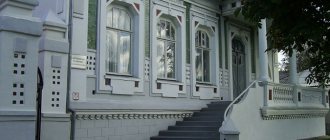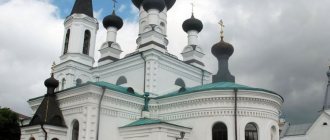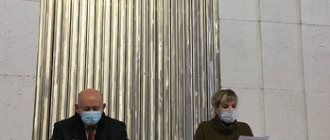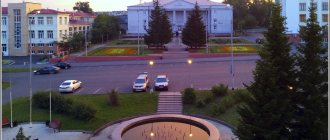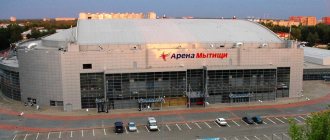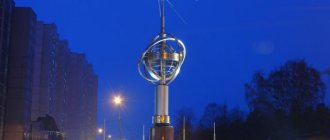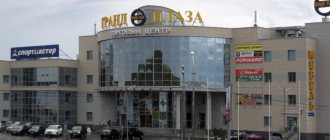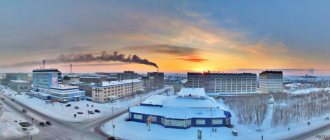Troitsk - attractions and what to see
Historical information. A visit to the city of Troitsk will undoubtedly give you pleasure. Although it is still not entirely appropriate to call it a city - since 2012 it has been part of the Moscow District. It is located just 20 kilometers southwest of the Moscow Ring Road, along the Kaluga Highway.
The history of Troitsk begins in the 17th century with the village of Troitsky. The first mention of the Troitskaya heath can be found in documents from 1627. Then the wasteland belonged to the lands of boyar I.I. Saltykova.
General information
Great progress in the development of the village of Troitsky began with the emergence of a large cloth factory in 1797. Although many historians dispute this date. Thanks to the factory, the village quickly turned into a large settlement. The factory is still one of the largest enterprises in Troitsk!
During the Patriotic War of 1812, the temporary headquarters of Napoleon's retreating troops was located in Troitsky. Historians believe that Napoleon spent two days of the existence of the headquarters in Troitsk in the Levshin manor house. Of course, there are no documents on this matter, but there is oral evidence.
In the fifties of the last century, Troitsk experienced the so-called “dacha period”. By decision of the Moscow Regional Council in 1955, the Krasnaya Pakhra holiday home, the children's playground of the Administration of the Council of Ministers of the RSFSR, the Children's Club "Soviet Writer", a residential village of the Construction Committee under the Council of Ministers of the USSR and a pioneer camp were annexed to the Trinity village. There were dachas of Tvardovsky, Alexander Solzhenitsyn, Yuri Nagibin, Vladimir Vysotsky, Lyudmila Zykina and other famous people.
In March 1977, Troitsk received city status. Its population then was 20 thousand people.
In January 2007, Troitsk was given the status of a science city, according to a decree of the Russian government. And rightfully so - now Troitsk is home to 10 of the largest research centers! These institutes conduct the most important research and development for the country. These institutions became city-forming for Troitsk.
The city is very cozy, beautiful and green, with a favorable environment. There are forests on all sides of the city, and there are no large industrial enterprises.
Troitsk has all the infrastructure for a comfortable life. The nearest metro station is 30 minutes away by shuttle bus. Today the city's population is 61 thousand people.
Each district has a coat of arms
New Moscow continues to develop. In 2022, the construction of 9 schools and 13 kindergartens is planned. Also, the construction of modern neighborhoods with all the necessary infrastructure continues here, from the arrangement of children's and sports grounds to medical institutions. Photo: Viktor Khabarov, “Evening Moscow” On July 1, New Moscow will celebrate its ninth anniversary. And they have already given her a nice gift. The districts were given a coat of arms. “BUT” found out what the new symbols of the TiNAO mean.
The process of creating coats of arms is quite complex. On the one hand, heraldry has its own laws and rules that facilitate this process. Color, shape - everything here has its meaning. On the other hand, the person who is drawing up the coat of arms must himself understand what needs to be depicted on it. Almost anything can appear in the picture.
“Even human parts of the body,” says Dmitry Makarov, candidate of historical sciences, specialist in heraldry.
And even animals that don’t exist at all! For example, the coat of arms of the settlement of Sosenskoye depicts a unicorn. And this is historically justified. Of course, no horned horses walked on this land. But for several centuries, this territory was owned by the Shuvalovs, prominent statesmen. Being representatives of a noble family, they had their own family coat of arms, which depicted a unicorn, which means purity, trust, courage, spirituality and sublimity.
So if you see something unusual on the coats of arms, know that it is historically justified.
By the way, all municipalities of the TiNAO have coats of arms. Now they have appeared at the TAO and NAO, indicating ownership of the territory. This is how it happened historically.
— Although the first coats of arms appeared in Europe in the 10th century. But they were intended for military operations in order to distinguish our own from strangers. And over time, they began to appear among states, regions and even noble families,” says historian Dmitry Makarov. — And if you are familiar with history, then you can quite understand what is depicted on certain coats of arms. But sometimes ordinary knowledge is not enough.
Trinity shamrock
The shamrock symbolizes the Holy Trinity, as well as the unification of territories. Birch leaf : on the one hand, according to Russian tradition, on the day of the Holy Trinity, icons were decorated with birch leaves. Hence the symbol of the district. On the other hand, a green birch leaf can mean a young developing city. Troitsk itself is relatively young. It began to form after the war, and received city status only in 1977 Notch : the Moscow coat of arms can be recognized immediately.
Modern heraldists came up with a notch specifically to show that this municipality is located on the territory of Moscow. Such a notch means the prong of the Kremlin. It is called the swallow's tail. The TAO coat of arms was dealt with in an unusual manner. On the one hand, it has an official “transcript”.
“It’s based on a birch leaf, the same one that can be seen on the coat of arms of Troitsk,” says Dmitry Makarov.
When the city district was part of the Moscow region, it received its name from the Church of the Holy Trinity, which was once located here. However, the historian interpreted the coat of arms a little differently.
— White is the color of purity. And here it may mean that enormous changes await this uncharted territory, says the historian. — And as we know, nowhere in the world there are no analogues to New Moscow in terms of the pace of development and construction.
Rose of Novomoskovsk district
White : this is nobility, frankness, purity. Green denotes abundance, hope for the best. Red denotes masculinity, determination Gold : source of life and wealth, both material and spiritual Rose : symbol of agricultural enterprises. The main ones on the territory of the Nenets Autonomous Okrug Form : in essence, all coats of arms are shields.
True, they come in different shapes. Ours, which is most often used in Russia, is called French. It has been the basis of all Russian heraldry since the time of Peter I. And all because the emperor appointed Francis Santi to the post of chief Russian heraldmaster, who adopted the French tradition - The coat of arms of the Nenets Autonomous Okrug was based on the coat of arms of the settlement of Moscow, which became the center of the entire district. Namely the rose that adorns it. The division into two parts shows that there are two important agricultural enterprises in the district, says Dmitry Markov.
This is the largest Moscow agricultural complex in Europe and a unique agricultural enterprise - the Ulyanovsk State Farm of Ornamental Horticulture. In the 20th century they became city-forming enterprises.
White - nobility, frankness, purity. And gold and green represent justice and abundance.
Nine achievements in nine years
1
In the Moskovsky settlement, the Salaryevo international bus station was opened in 2022, from which you can travel to Belarus, Moldova, Georgia, Germany, Ukraine and 35 Russian cities.
2
In nine years, eight metro stations were built here: Rumyantsevo, Salaryevo, Filatov Lug, Prokshino, Olkhovaya, Kommunarka, Govorovo and Rasskazovka. You can also get to the settlement of Ryazanovskoye and the urban district of Shcherbinka using the MCD-2.
3
For nine years in New Moscow, you cannot find a settlement or urban district where the construction of schools and kindergartens has not begun. On September 1, 2022, about 52 thousand students and 24 thousand pupils crossed the threshold of general education institutions.
Photo: Viktor Khabarov, “Evening Moscow”
4
New Moscow was one of the first to take the hit during the pandemic. The newest hospital in Kommunarka with the most modern equipment appeared here. She took the first blow of the pandemic.
5
The infectious diseases hospital in the Voronovskoye settlement, built in record time, was among the finalists of the international MIPIM Awards 2022.
6
About 10 clinics were built in the TiNAO over nine years, and the number of doctors in the medical organizations of the TiNAO increased from 383 to 690, nursing staff - from 671 to 921.
Photo: Viktor Khabarov, “Evening Moscow”
7
The embankment in the Voronovskoye settlement, after large-scale improvement, has become a certified track for holding All-Russian race walking competitions. In the future, they are preparing to welcome athletes from all over the world.
8
About 30 road and transport infrastructure facilities were built/reconstructed, including 5 railway overpasses with a total length of 212 km. In total, by 2024, about 492 km of roads will be built and reconstructed on the territory of New Moscow.
9
There are 70 scientific and industrial facilities on the territory of New Moscow. On March 10, 2022, on the basis of Technospark, the country’s only Russian center for flexible electronics was opened, which makes thin-film transistor matrices and key components for various devices.
SURVEY
Residents of New Moscow tell what, in their opinion, has changed in TiNAO since 2012.
Anastasia Esina , resident of the Vnukovskoye settlement
I can’t help but say how clean New Moscow has become. There is a huge difference. I live in Vnukovsky and often go to Novofedorovsky and notice how these territories are monitored. They mow the grass and take care of every street. And also pay attention: in almost every settlement there are luxurious parks where you can walk, barbecue, and relax with children.
Danil Chikirenda , resident of the Troitsk urban district
My friends who live in Filimonkovsky stopped getting stuck in traffic jams. Their journey along the Maryino-Salaryevo highway takes no more than fifteen minutes! Can you imagine this? And if you travel by public transport, there are now more buses and minibuses. And they started walking much more often.
Alexander Matveev , history teacher at school No. 2120 in the Moskovsky settlement
It seems to me that the quality of education that students of the TiNAO receive has improved.
Cadet, medical, and engineering classes appeared in schools in the former Moscow region. Participation in such projects made it possible to enrich the material base of schools and regularly visit museums, galleries, and research centers. Many schools have turned not only into educational, but also into scientific complexes, and to some extent have become educational and cultural centers of the TiNAO. Post Views: 76
Troitskoye village, disappeared estate and old church
We recently wrote about the lost estate of the artist V.G. Perov, and now we can’t help but tell another story connected with those places. Very close to the huge thickets where the house of the great painter used to stand, on the high bank of the river is the ancient village of Troitskoye. Until recently, there was a small wooden estate in it, and the Church of the Life-Giving Trinity, built in 1794, still stands.
The road crosses the Katysh River on a bridge, goes around a small forest and climbs steeply up a hill, where the roofs of houses can already be seen. In appearance, this is an ordinary dacha village, of which there are now many throughout the Moscow region, but the ruins of an ancient church behind a metal construction fence immediately betray the ancient history of these places. Indeed, the village was first mentioned in the 16th century, although at that time it was called Aleksandrovsky. From 1625 to 1712, the village belonged to the family of the boyar and governor Mikhail Yuryevich Tatishchev, whose great-granddaughter was the Russian Empress Anna Ioannovna Romanova. M.Yu. Tatishchev builds a new stone church instead of a burnt wooden church, consecrated in honor of the Holy Trinity. Thanks to this event, the village began to be called Troitskoye-Alexandrovo, and later simply Troitskoye.
After the Tatishchevs, the village was owned by the noble family of the Kislinskys. It was under them, in the middle of the 18th century, that the main appearance of the estate, ponds and park was formed, and in 1794 the church was rebuilt. The main manor house, which went down in history, was built later - at the beginning of the 19th century. It stood literally three dozen meters from the entrance to the temple, forming together with it a beautiful architectural ensemble that harmoniously complemented the surrounding landscape. The house was made of wood, one floor with mezzanines, had two wings and a winter garden.
At the end of the 18th century, the estate was owned by Prince Alexei Grigorievich Orlov-Chesmensky, who received the name for his surname for his heroism in the Battle of Chesmensky. The prince did not often appear at his country estate, but still managed to rebuild the main house, outbuildings and outbuildings. At that time, the interiors of the house were especially diverse: intricate paintings, wood carvings, bas-reliefs, beautiful furniture, huge chandeliers, wall sconces, paintings and mirrors. Balls were held in the large hall, which attracted guests from all over the area and even from the capital. The prince also paid attention to the territory adjacent to the estate, turning it into a work of landscape art.
In 1808, after the death of A.G. Orlov-Chesmensky, his wife sold the estate to landowner Elizaveta Yakovlevna Myachkova. The new owner was not known for her thriftiness, and therefore the estate soon fell into disrepair: the park began to overgrow, the house required repairs. Having failed to improve her business and life, the landowner got rid of the estate, selling it to the manufacturer Alpatov, who, in turn, quite soon resold it to the railway engineer Voznesensky. He visited the country only in the summer, but still brought some order to the estate. The next owner of Troitsky was the landowner Lavrentieva, but she also did not own the estate for long, selling it to the last owner - ophthalmologist Konstantin Vladimirovich Snegirev.
K.S. Snegirev was an outstanding scientist and doctor who forever entered the history of Russian medicine. He lived and worked in Moscow for a long time until he acquired a small Troitskoye estate in the north of the Moscow region, where he spent more and more time every year until he moved completely. But K.S. rejoiced in the silence, peace and views of nature near Moscow. Snegirev did not live long - in 1917 his house was taken away from him and he had to return to Moscow.
For some time, the estate was empty, and then a junior high school was opened in the doctor’s house, significantly renovating the building. However, by the middle of the 20th century there were almost no young people left in Troitsky, so the school had to be closed. In the late 80s, the Klin City Executive Committee transferred the territory of the former estate to the then-famous banking organization Menatep, which promised to carry out restoration work, but never kept its word. The main manor house, a rare example of wooden classicism, disappeared forever in the early 90s - they say it burned down. Now in its place there are only bushes and the remains of the foundation.
The Trinity Church, rising directly opposite the place where the house used to be, also almost completely collapsed during the 20th century. It was not closed immediately - services were carried out until 1930. Apparently, the location remote from regional centers and the indifference of local residents had an impact.
First, a food warehouse was set up in the church, and then the war began. In 1942, during the liberation of the village, a three-tiered bell tower, on which a German machine gunner had settled, was destroyed. The temple also suffered greatly, but it survived. After the war, it was almost never repaired and a glass-blowing workshop was set up inside, which, however, did not last long.
The Trinity Church was a very beautiful rotunda with two-column porticoes and a light drum topped with a dome, a warm refectory with two side chapels, added in 1862, and a three-tier bell tower. By the end of the 20th century, only the severely dilapidated main volume of the temple remained standing - everything else was destroyed by people and time. The vaults collapsed in several places, the wall cracked and we, not being builders, would say that the temple can no longer be restored. But walking around, we were surprised to notice scaffolding, a small trailer, and heard the sound of a hammer coming from somewhere inside. As it soon became clear, the temple is being restored slowly. There are only a few people working on this, but the process is underway. Somewhere the brickwork has already been rebuilt, the roof has been re-roofed, and all the rubbish that has accumulated inside over several decades has been thrown out. There is still a lot of work to be done, but a start has been made.
Just as we were getting ready to leave, we suddenly noticed a boulder with a sign nearby.
Korin Alexey Mikhailovich was an outstanding artist, whose paintings can be seen in the Tretyakov Gallery, the Russian Museum, the Museum of the city of Ples, his works participated in world exhibitions in Paris in 1900 and in Rome in 1911. He spent the last years of his life in a quiet corner of Moscow - the village of Maryino, located close to Troitsky. Now his name, like the name of V.G. Perov, who lived next door, is almost forgotten in these places.
Coordinates of the village of Troitskoye: 56 ° 12'5″N 36 °43'2″E


